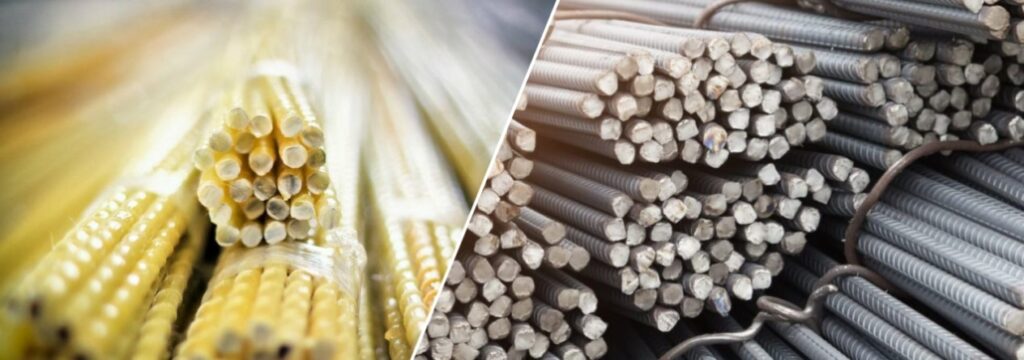When it comes to rebars used universally in industrial and civil fields, you might have been wondering about the differences between the FRP rebar and its steel counterpart. Despite obvious trends in various industries shifting to FRP rebars, some companies are still doubtful and conduct multiple pieces of research on FRP vs. steel prospects, characteristics, and performance.
Content
Steel Rebar and Its Properties
Steel is known for its great qualities deployed across various industries. The downside of steel is that it is prone to moisture and, consequently, corrosion. All sorts of chemical reactions, such as oxidation, generate a negative impact on steel properties eventually. Thus, steel rebar applications are restricted in some industries.
The advantage of the low initial cost is overlapped by higher transportation and on-site installation costs given its heavy weight. On a long-term horizon, corroded steel rebar requires costly maintenance and results in increased tensile load on concrete structures.
FRP Rebar and Its Properties
FRP, or fibre-reinforced polymer, has been replacing steel across diverse industries. Being resistant to corrosion and various chemical processes and reactions, FRP has become the preferred material for marine and open-air exposed applications.
Various additives used for enhancing some properties can increase the overall tensile capacity and endurance of FRP products, including rebar, silos, tanks, etc. The tensile strength of fibre rebar is 20% higher in comparison with a steel bar.
The material bonding force of fibre reinforcement is considerably stronger compared to steel; this explains better operational endurance of GFRP rebar.
Customizable manufacturing allows tailoring resins used for the FRP rebar production to meet niche-specific requirements, for instance, enhancing abrasion or corrosion resistance.
FRP rebar vs. Steel rebar
Another crucial advantage of GFRP vs steel is it’s lightweight. FRP rebar weighs only ¼ of steel rebar of the equivalent size. Hence, the use of FRP rebar lowers costs for shipping and installation.
One more important factor is impact resistance. Under heavy working load FRP won’t deform permanently because the polymer matrix intensified by resins is capable of distributing the impact load, preventing the surface from being damaged. In similar conditions, particularly in lower temperatures, steel products might be deformed.
Despite having a similarly wide range of applications, FRP differs from steel in terms of electrical and thermal conductivity. Steel is a good conductor of electricity and heat, while FRP has lower thermal conductivity and null electrical conductivity. In an environment with thermal fluctuations, FRP demonstrates more stable properties than steel whose characteristics may vary as a result of external temperature impact.
| Properties | Frp rebar | Steel rebar |
| Weight | ¼ of steel weight | 10mm, 0.617kg/m (or 0.188 kg/ft) |
| Strength | 206.5 mpa | 248.2 mpa |
| electrical conductivity | Non-conductive | Conductive |
| Thermal conductivity | Low | High |
| Corrosion resistance | High (unaffected by water) | Low (without expensive galvanisation treatment bars of steel are subject to oxidation) |
| Heavy load resistance | No permanent deformation | Can be permanently deformed |
| Costs | Lower manufacturing costs, maintenance costs, and transportation expenses (related to lightweight) | Lower material costs but higher overall costs of production, transportation, installation, and technical maintenance |
Industrial and commercial applications of FRP rebar include shield tunnels, bridges, airports, highways, water stations, waste conservancy, sewage and chemical plants, as well as all sorts of coastal projects.
Final thoughts
When it comes to a choice of FRP rebar vs. steel rebar, FRP wins in many applications due to its superior thermal, corrosion, and chemical. Add here a much lighter weight that facilitates transportation by further cost reduction, the choice seems pretty obvious. Yet still, steel rebars are irreplaceable by FRP in industrial applications that require electrical conductivity as a mandatory attribute. Other than highly-specialised applications, GFRP rebar is rightly seen as a cost-effective alternative to steel rebar.
For more information on GFRP rebar equipment, FRP rebar machines, and other innovative solutions, visit Composite-Tech’s website today and discover how we are shaping the future of construction.
Learn more:

